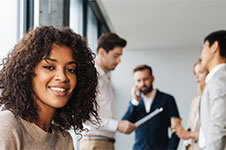Quintillion’s fiber-optic cable network currently extends 1,200 miles under the sea and 500 miles over land. It’s the first and only system of its kind in Alaska and its world-class infrastructure can deliver sub-gigabit, gigabit, and terabit bandwidth services. The cable itself is buried up to twelve feet below the seabed and there are six cable landings, installed 60-80 feet deep in steel conduit.
That means Stage 1 of its plan is complete and operating, serving America’s largest oil and gas fields at Prudhoe Bay and establishing communications with satellites. It’s time for Stage 2, which involves connecting Alaska to Washington State and laying a subsea cable from Washington State to Japan. The new link will improve diversity, reduce latency, and strengthen critical links to Asia.
Sean Bergin is President and Co-Founder of Quintillion partner AP Telecom and Chairman of the Pacific Telecommunications Council. We spoke to him to discuss what this important new link, the JAWS Trans-Pacific fiber cable, means for the global telecommunications industry.
Want to learn what JAWS means for you? Talk to Quintillion’s team of experts.
Link Between Quintillion and AP Telecom
Let us start at the beginning. AP Telecom is an award-winning digital infrastructure consulting firm. The company is providing commercial support to Quintillion’s new JAWS Trans-Pacific fiber cable and helping Quintillion monetize the submarine cable it is laying between the U.S. and Japan.
AP Telecom is a global company with access to the world’s biggest buyers, therefore its team can help Quintillion connect with corporations and business leaders who are interested in participating in projects such as this one. Additionally, AP Telecom helps Quintillion develop its pricing models as well as the commercial framework that will eventually be introduced to the market.
“That’s our role,” explains Bergin. “It is about making sure the global submarine cable community is aware that the project is happening. And it is our role as consultants to determine which parties out there are interested in participating as a customer on this cable project.”
Global Impact of the JAWS Trans-Pacific Fiber Cable

The vast majority of internet traffic is carried over subsea cables. Bergin estimates it is actually as much as ninety-five percent. These cables are an essential link for a wide variety of applications.
“A lot of people think [data is] delivered over satellite, but it’s not,” says Bergin. “Pretty much all of it is over submarine cables, apart from the odd patch in far-flung rural areas and really remote locations – Northern Alaska is a fitting example of that. The role of subsea cables is quite profound in the context of what we know as the internet. Without them, it just would not work.”
There is no other technology available today, or in the immediate future, which is in a position to replace these cables. They facilitate everything from secure financial transactions – transferring billions of dollars a day between countries – to the average person looking at Facebook.
When it comes to the Pacific, things have been quiet on the cable-building front for the last few years. That is all changing, says Bergin, with several new projects coming into play. The PC1, which is the most prominent cable connecting Japan and the U.S., is getting towards the end of its life and is set to be decommissioned within the next five years. Very soon there will be an “absolute need” for a new cable to provide connectivity and diversity between North America and Asia. Additionally, diversity is critical. Not just diversity of route, but diversity of suppliers. We are seeing a significant amount of build activity intra-Asia, with many of these new cables reaching Japan. It will be critical that there is enough matched, diverse supply between Japan and the US to complete the route between Southeast Asia and the US.
Expanding Relationships with Other Nations
Quintillion recently brought on Dr. Niiro Yasuhiko as its Senior Strategic Advisor in Japan. Dr. Niiro-san is an expert in undersea fiber-optic systems who previously worked as a professor and engineer. He managed the first Trans-Pacific fiber-optical submarine cable, TPC-3, which was installed in 1989. He has also worked on many other global submarine communications projects around the world.
Interestingly, the team at AP Telecom has known Dr. Niiro-san for about 20 years.
“He’s very respected in industry and government, so he’s absolutely the right person to be involved in this project,” says Bergin. “[His appointment] has come at the perfect time as this project matures. We are confident he is the right guy for this project. It is a positive move from Quintillion.”
Dr. Niiro-san will be an invaluable addition to the team as construction moves forward on the JAWS Trans-Pacific fiber cable and Quintillion develops a closer relationship with Japan.
What Does Diversity Mean in This Context?
The JAWS Trans-Pacific fiber cable is critical from a diversity perspective. Essentially, “diversity” means having multiple pathways by which data can travel. That way, if there is an issue with one cable, or another reaches the end of its life, there are other routes available for that data.
“It’s not just important to have multiple cables, but also diversity of where those cables land just to provide that extra layer of security,” says Bergin. “JAWS is planned to end up in Washington State, and it will be the first cable to do so in 20-something years, so it’s an exciting project in that context.”
JAWS Project Progress Update
Permitting and regulatory requirements are always challenging with large infrastructure projects. Washington State, which will be home to the JAWS Trans-Pacific fiber cable’s U.S. landing site, is home to a significant amount of native-owned land and as a result the rules are stringent. However, Quintillion’s team has successfully met all the requirements to give the project a green light.
“Typically, with a submarine cable project, the licensing and permitting process is the longest pole in the tent, the hardest bit to solve, and they’ve nailed that,” says Bergin. “The quality of the team at Quintillion and the experience they have had working in these sorts of environments before has served them really well. I think the hard yards have been done; now it is all about commercialization.”
In other words, it is an extremely exciting time for everyone involved in the project, as well as those eagerly awaiting its completion, because nothing is holding it back at this point in its development.
Other Global Fiber Cable Developments
The JAWS Trans-Pacific fiber cable is a huge development for the global network. However, the industry is also seeing a number of other significant changes. Bergin highlights two examples.
First, each carrier has historically been responsible for buying the pipes they need to transport their data across the world. However, thing have changed in recent times. We are now seeing over-the-top players (OTTs) – such as Google, Facebook, and Amazon – cache content within their cloud regions and shoulder a substantial portion of that responsibility. As a result, it is now common to hear about “Amazon cloud regions” or “Microsoft cloud regions.” It brings content closer to the end users.
Content delivery networks and OTTs are spending a lot of money building cables around the world and serving content up locally. In less than a decade, it has brought about massive change.
Second, there has been a shift to newer technology within the submarine cables themselves. That means it is possible to carry much more capacity per fiber pair than has ever been possible given the advent of SDM technology (Spatial Division Multiplexing) coupled with the flexibility WSS (wavelength selective switch) brings.
Next Steps Forward for Quintillion
Step 1 was growing the terrestrial network, Step 2A is expanding the subsea network, and Step 2B is even more exciting. It involves expanding operations at the Arctic ground station, as well as connecting Alaska to Canada, connecting Canada to London, and building landing stations in Iceland and at Thule Air Base in Pituffik, Greenland. The future of Arctic fiber-optic communications is here.
Looking for technical details of Quintillion projects? Visit our website to learn more.















